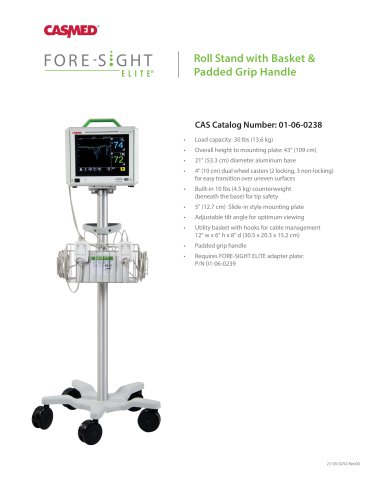 Website:
CAS Medical Systems, Inc. CASMED
Website:
CAS Medical Systems, Inc. CASMED
Catalog excerpts

• Melanin Matters: Skin Tone and Accuracy in Tissue Oximetry • Evidence to support the use of FORE-SIGHT® tissue oximetry W for improved performance in dark-skinned patients. • The amount of melanin in a patient's skin generally correlates with skin tone (the darker the skin, the more melanin present), but patients may also have sub-epidermal "birthmarks" or other non-visible melanin deposits. • The absorption of NIR light by melanin can cause tissue oximeters to interpret higher amounts of deoxygenated hemoglobin than are actually present, resulting in a lower StO2 (rSO2) reading. • Falsely low readings can lead to unnecessary interventions1, creating the potential for increased risks for the patient, and increased cost of care. • To address the issue of melanin interference in tissue oximetry readings, FORE-SIGHT tissue oximetry compensates for chromophores with similar absorption profiles to melanin. • Evidence suggests that the INVOS™ monitor could be subject to significant differences (~12 percentage points on average) in rSO2 readings with regard to dark-skinned verses light-skinned patients.2 • Internal FORE-SIGHT data shows a much smaller difference (~1 percentage point on average), suggesting the FORESIGHT technology may generate more consistent results across patients with both light and dark skin. • One study utilizing the INVOS monitor showed that a material subset of African American patients had preinduction rSO2 readings of less than 50%2, below an intervention threshold according to historical clinical guidelines for using the INVOS monitor. • Other biological chromophores such as those present in patients with high bilirubin or in newborns with meconium in their stools can present similarly to melanin, and evidence suggests that FORE-SIGHT algorithms can compensate for those substances as well.3,4
Open the catalog to page 1
ear Infrared Spectroscopy has been utilized in medicine for decades, always with the goal of providing clinicians with more information about their patients while remaining noninvasive. Many early limitations of the technology have been largely overcome. However, not all tissue oximeters have sufficiently addressed the issue of melanin interference. Melanin’s purpose in the body is to absorb light (namely, from the sun) to protect internal organs from damage. When exposed to too much sunlight, skin may tan or burn: this is the result of the body releasing more melanin to protect itself....
Open the catalog to page 2
In response to these publications, we conducted a retrospective review of FORE-SIGHT validation data that resulted in cerebral oximetry readings from 101 subjects with either light or dark skin (moderate skin tone subjects were excluded, consistent with the Medstar publication) breathing room air. The results of this analysis can be seen in Figure 4. While INVOS monitoring demonstrated a 12-point difference in mean pre-induction oximetry values, FORESIGHT monitoring demonstrated only a 1-point difference between the two groups. The distributions of data for the two groups are aligned, and...
Open the catalog to page 3
a. ORE‐SIGHT ELITE F Absolute Tissue Oximeter P/N: 01‐06‐3000 b. reamp Cable P 4m P/N: 01‐06-3100 6.5m P/N: 01‐06-3101 c. arge Sensor L Adults ≥ 40 kg P/N: 01‐07-2103 20 sensors/case Call our Customer Support: 203.488.6056 • 800.227.4414 or contact your local sales representative. References 1. eldmeier C, Pitcher H, Hirose H, Cavarocchi N. Relative vs. Absolute Cerebral Oximetry: does a Skin Pigmentation Effect Normal values on cardiopulmonary F Support? Austin Journal of Surgery. 2014;1(1): 1003. 2. un X, Ellis J, Corso P, Hill P, Chen F, Lindsay J. Skin pigmentation interferes with the...
Open the catalog to page 4All CAS Medical Systems catalogs and technical brochures
-
FSE_Mounting_Solutions
2 Pages
-
Connectivity Solutions
4 Pages
-
FSE_Pediatric
4 Pages
-
FORE-SIGHT ELITE Adult
4 Pages





